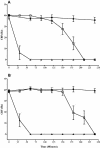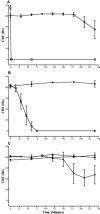Streptococcus pneumoniae-induced inhibition of rat ependymal cilia is attenuated by antipneumolysin antibody
- PMID: 15501805
- PMCID: PMC523015
- DOI: 10.1128/IAI.72.11.6694-6698.2004
Streptococcus pneumoniae-induced inhibition of rat ependymal cilia is attenuated by antipneumolysin antibody
Abstract
Ciliated ependymal cells line the ventricular surfaces and aqueducts of the brain. In ex vivo experiments, pneumolysin caused rapid inhibition of the ependymal ciliary beat frequency and caused ependymal cell disruption. Wild-type pneumococci and pneumococci deficient in pneumolysin caused ciliary slowing, but penicillin lysis of wild-type, not pneumolysin-deficient, pneumococci increased the extent of ciliary inhibition. This effect was abolished by antipneumolysin antibody. Ependymal ciliary stasis by purified pneumolysin was also blocked by the addition of antipneumolysin monoclonal antibodies. These data show that antibiotic lysis of Streptococcus pneumoniae can be detrimental to the ciliated ependyma and that antipneumolysin antibody may have a therapeutic potential.
Figures



Similar articles
-
Relative roles of pneumolysin and hydrogen peroxide from Streptococcus pneumoniae in inhibition of ependymal ciliary beat frequency.Infect Immun. 2000 Mar;68(3):1557-62. doi: 10.1128/IAI.68.3.1557-1562.2000. Infect Immun. 2000. PMID: 10678974 Free PMC article.
-
The effect of the pneumococcal toxin, pneumolysin on brain ependymal cilia.Microb Pathog. 1999 Nov;27(5):303-9. doi: 10.1006/mpat.1999.0306. Microb Pathog. 1999. PMID: 10547234
-
Effect of pneumolysin on rat brain ciliary function: comparison of brain slices with cultured ependymal cells.Pediatr Res. 2000 Mar;47(3):381-4. doi: 10.1203/00006450-200003000-00016. Pediatr Res. 2000. PMID: 10709739
-
Streptococcus pneumoniae produces a second haemolysin that is distinct from pneumolysin.Microb Pathog. 1997 Mar;22(3):129-32. doi: 10.1006/mpat.1996.0098. Microb Pathog. 1997. PMID: 9075215
-
Ependymal and choroidal cells in culture: characterization and functional differentiation.Microsc Res Tech. 1998 Apr 15;41(2):124-57. doi: 10.1002/(SICI)1097-0029(19980415)41:2<124::AID-JEMT3>3.0.CO;2-U. Microsc Res Tech. 1998. PMID: 9579599 Review.
Cited by
-
Beneficial and Harmful Interactions of Antibiotics with Microbial Pathogens and the Host Innate Immune System.Pharmaceuticals (Basel). 2010 May 25;3(5):1694-1710. doi: 10.3390/ph3051694. Pharmaceuticals (Basel). 2010. PMID: 27713324 Free PMC article. Review.
-
High-Speed Video Microscopy of Ependymal Cilia in Brain Organotypic and Cell Culture Models.Methods Mol Biol. 2024;2725:239-250. doi: 10.1007/978-1-0716-3507-0_15. Methods Mol Biol. 2024. PMID: 37856029
-
Bacterial pore-forming cytolysins induce neuronal damage in a rat model of neonatal meningitis.J Infect Dis. 2011 Feb 1;203(3):393-400. doi: 10.1093/infdis/jiq047. Epub 2010 Dec 24. J Infect Dis. 2011. PMID: 21186256 Free PMC article.
-
Recent advances in our understanding of Streptococcus pneumoniae infection.F1000Prime Rep. 2014 Sep 4;6:82. doi: 10.12703/P6-82. eCollection 2014. F1000Prime Rep. 2014. PMID: 25343039 Free PMC article. Review.
-
Hydrogen peroxide at a concentration used during neurosurgery disrupts ciliary function and causes extensive damage to the ciliated ependyma of the brain.Childs Nerv Syst. 2009 May;25(5):559-61. doi: 10.1007/s00381-008-0768-4. Epub 2008 Dec 24. Childs Nerv Syst. 2009. PMID: 19107492
References
MeSH terms
Substances
LinkOut - more resources
Full Text Sources
Other Literature Sources

